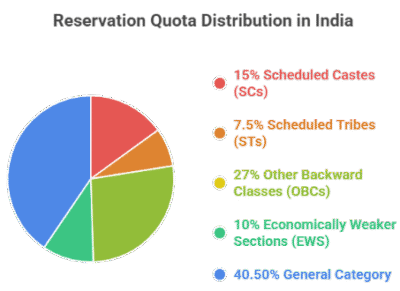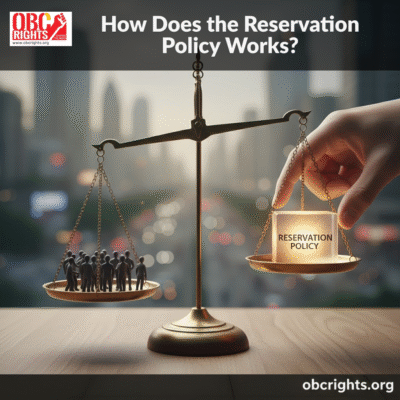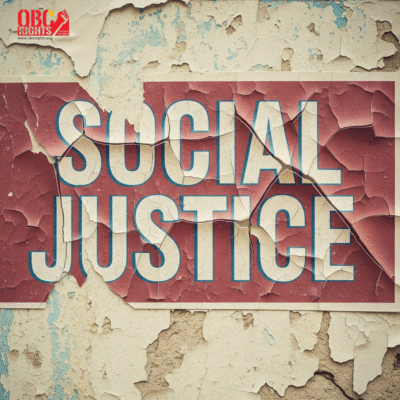When people ask “how does the reservation policy works?”, they are not just asking about numbers or percentages — they are asking how India tries to heal centuries of exclusion through law and opportunity.
Reservation is not a shortcut; it is a corrective mechanism. It works to balance access, representation, and dignity for those who were historically denied both education and employment because of their birth. Yet, even after decades of implementation, the question remains relevant: how does the reservation policy works in practice, and is it achieving real equality?
The Constitutional Compass
To understand how does the reservation policy works, we must start with the Constitution. The Constitution, through Articles 15(4) and 16(4), allows the State to implement special measures aimed at promoting the social and educational development of backward communities. It is not a political favour; it is a constitutional duty rooted in the idea of substantive equality — equality that recognizes unequal starting points.
The architects of our Constitution knew that merit alone cannot flourish in a field that is already unequal. Hence, reservation became a tool to level the playing field, not to tilt it.
The Mechanics of the System
So, practically speaking, how does the reservation policy works?
It allocates a fixed share of seats in educational institutions, public employment, and sometimes in elected bodies to historically marginalized groups — Scheduled Castes (SCs), Scheduled Tribes (STs), and Other Backward Classes (OBCs).
At the national level:
- SCs get 15%,
- STs get 7.5%, and
- OBCs (Non-Creamy Layer) get 27%,
making a total of 49.5% in central institutions and government jobs.
Additionally, a 10% quota for Economically Weaker Sections (EWS) now exists for the poor among non-reserved categories.

In Tamil Nadu, the reservation policy works differently. The State follows its own model with 69% reservation, protected by the Ninth Schedule to prevent judicial interference. This includes
- Backward Classes (BC) – 30% total
- BC – General: 26.5%
- BC – Muslims: 3.5%
- Scheduled Castes (SC) – 18% total
- SC (Others): 15%
- Arunthathiyar (Within SC): 3%
- Scheduled Tribes (ST) – 1% (no sub-categories)
The Idea of “Creamy Layer”
To ensure fairness within OBCs, the “creamy layer” concept was introduced. It excludes those whose annual family income exceeds ₹8 lakh, ensuring that the benefits reach those who genuinely need them. This fine-tuning shows how does the reservation policy works dynamically, evolving with changing social realities.
Reservation Beyond Numbers
Critics often reduce reservation to mere percentages. But if we look deeper into how does the reservation policy works, it becomes clear that it is not just about quotas — it is about representation and voice.
When a first-generation OBC student enters an IIT, or when a Dalit officer signs a government file, it breaks centuries of invisibility. Reservation opens doors that were long sealed, allowing democracy to finally look like the people it represents.
Gaps and Challenges
Despite progress, inequalities persist. Many OBC groups remain under-represented even within the reserved share. Implementation gaps, delayed certificates, and confusion about eligibility often deny rightful benefits.
The absence of caste-based data in the national census further complicates policy reform. Without knowing who is left behind, how can we plan inclusion effectively? This is the next frontier in refining how does the reservation policy works — making it evidence-based and equitable within categories.
Why Reservation Still Matters?
Reservation is not about perpetuating divisions; it is about repairing structural damage. Societies that refuse to address injustice end up deepening it. Until schools, colleges, and offices reflect India’s social diversity, the moral question of how does the reservation policy works will continue to matter.
When the policy helps a child from a remote village become a doctor or an engineer, it proves that equality is not a dream — it’s a process, and reservation alone is it’s foundation.
The Road Ahead
The future of India’s reservation policy depends on fair implementation, data-driven review, and expansion into new domains like private employment, technology, and entrepreneurship. As India modernizes, exclusion takes new forms — digital, economic, and linguistic. The system must evolve to meet them.
We must ask ourselves not whether reservations should exist, but how better the reservation policy works to ensure genuine empowerment for every backward community.
To express your concerns or ventilate your feelings, please mail to: obcrights.sfrbc@gmail.com



